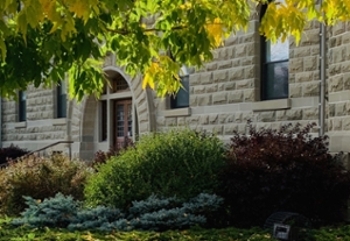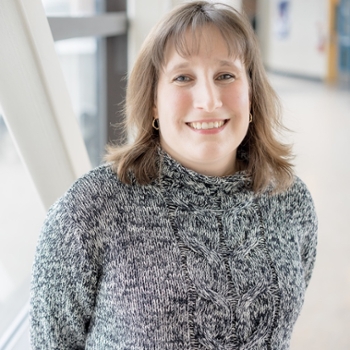Arts departments pivot to online (Part 1) - MLL
Mon. Mar. 16, 2020
 It might be quiet on campus this fall. But it’s business as usual in the departments in Arts – except that courses and labs are being offered remotely. Due to COVD-19, the decision was made to pivot to online. As I don’t have the best view from my basement office, I wanted to find out more about how things were going in some of our departments. I met via Zoom with Adina Balint, Chair of the Department of Modern Languages and Literatures (MLL), and Rachel Berg, Office Manager for the Departments of MLL and Religion and Culture/East Asian Languages and Cultures, to get a sense of how things are going in MLL.
It might be quiet on campus this fall. But it’s business as usual in the departments in Arts – except that courses and labs are being offered remotely. Due to COVD-19, the decision was made to pivot to online. As I don’t have the best view from my basement office, I wanted to find out more about how things were going in some of our departments. I met via Zoom with Adina Balint, Chair of the Department of Modern Languages and Literatures (MLL), and Rachel Berg, Office Manager for the Departments of MLL and Religion and Culture/East Asian Languages and Cultures, to get a sense of how things are going in MLL.
Balint and Berg agreed that the first weeks of class went smoothly, with fewer issues than in other years. Students, perhaps uncertain about how this was going to look, seemed to have prepared ahead.
Before we met, Dr. Balint had contacted department members to find out more about their teaching experience thus far. Balint notes their responses were largely positive though, as she says, some shared their thoughts about challenges they’re facing or expect to face in the weeks to come. Balint had asked members to speak in particular to their experiences teaching language courses, e.g., Elementary French, versus content courses, e.g., 19th Century Poetry and Drama, remotely. As we’ll see, this led to some interesting discussion.
Balint expresses her appreciation for the leadership shown by three faculty members, in particular, this fall. Mary LeMaître, Instructor in the French Studies program, coordinates first- and second-year language courses and is the French Oral Lab coordinator. Balint says that Dr. LeMaître took this role seriously, offering workshops via Zoom about teaching and evaluating students online and through Nexus. Monica Ruiz, Instructor in the Spanish Studies program, and Kristen Lovrien-Meuwese, Instructor in the German Studies program, offered extensive support to CAS members and to TAs. Balint adds that Drs. LeMaître and Lovrien-Meuwese were enthusiastic in their approach to teaching online, both researching and sharing their findings with others in the department. This was important, says Balint, as it “created a sense of connection among us in the department.”
Lectures and labs
So just how does this work? For lectures and labs, department members report using a mix of Zoom and Nexus, as outlined below by Mélanie Sourisseau, a CAS member and TA in the French Studies Program:
- “The breakout rooms in Zoom are useful for group work.”
- “The share screen option in Nexus allows the class to view web pages and documents together.”
- “Publishing items on Nexus replaces what would have been printed on handouts.”
One member described how she meets via Zoom once per week to lecture and explain concepts, while the rest of the coursework is done as activities on Nexus.
Sofia Bach, a new CAS member in the French Studies Program, shared that she’d created a public discussion board on Nexus where both she and the students can contribute. She has also been using the interactive tools, such as Mentimeter, which allows instructors to interact with their students in real-time (to create polls, etc.) and Kahoot, a game-based learning platform.

Dr. Samantha Cook, Assistant Professor in French Studies, offered some interesting thoughts on the teaching of language courses as opposed to content courses remotely.
Photo credit: Rachel Berg
Samantha Cook, Assistant Professor in the French Studies Program, gave an enthusiastic plug for Zoom. In some ways, Dr. Cook says, Zoom might be better than in-class courses: (i) “no front and back of the class,” (ii) no problems hearing, (iii) students can listen even if they don’t want to be seen, and (iv) no commute. But, she cautions, this would only be the case in content courses, and not for language learning. To be effective, she says, language learning requires active participation. With Zoom, she says, “the accountability needed for regular language improvement is at least partly lost when students are not there in person. It’s too easy to turn off camera when things get challenging.” Sofia Bach agrees that in language courses, students need to actively participate, both with the instructor and with one another, and that this is a challenge in the online format. “Encouraging the students to come to the online office hour and creating a public discussion board on Nexus are two solutions I am trying out,” she says.
Challenges
There have been issues, to be sure, such as technical problems, especially in the early days, and some students have had network connection issues. Some faculty anticipate that evaluation is going to be a challenge. As one faculty member noted, grading writing is most easily done directly on the students’ paper. Another member expressed concern about academic integrity, pointing out that “it’s difficult to know what students are doing on the other side of the screen. I wish there were a more secure way to give tests.”
Underlying all of the undertakings, I’m hearing, is the increased need for time. Time to be able to offer the same course as in previous years, but online. Time to learn new types of technology. Time to research new ways of teaching. But the other thing I’m hearing is how well students have responded to the shift to online and how highly motivated they seem this year. As Dr. Sébastien Roldan put it, “In my opinion, students seem more involved, more eager to learn, more determined at succeeding and more patient with their instructors.” This is a good thing, as this year - even more than in others - our faculty members deserve our thanks, gratitude, and lots of patience.
See also:
Arts departments pivot to online (Part 2) - language teaching
